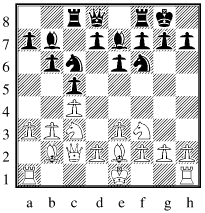
April 2012
Alsager B defaulted their second division game at Cheddleton B, while Alsager's A team defaulted a board at Stafford A. Fenton became the first club this season to get their sums wrong when their C team exceeded the fourth division grading limit at home to Cheddleton F. In this case the penalty simply served to increase the margin of defeat, so has no effect on the league table.
Division 1
|
Division 2
|
The larger second division has a later intended finish date, and a smaller backlog of three matches. The B teams of Newcastle and Cheddleton both strengthened their positions with two wins during March, reducing the contest to a three way one with Knights who still have to meet both the aforementioned B teams. The foot of the table is still crowded, with no clarity as to which of Alsager, Fenton and Rooks will take the wooden spoon.
Division 3
|
Division 4
|
Division four has been the best behaved division with just one postponement in its 56 game schedule. Cheddleton E have held off the attentions of their F team and of Fenton C to take the title, whilst at the other end Newcastle E's win over Alsager D in their last match of the season enabled them to climb off the foot of the table at the expense of their opponents.
All the NSDCA cup semi-finals have been completed so we know the line-ups for the finals. Holmes Chapel have the greatest interest in these with three finalists, missing out just on the final of the Minor Cup for the Perry Trophy. Cheddleton seek to top and tail these competitions with finalists in the open and Minor cups, whilst the remaining places are filled one each by Alsager (Major), Newcastle (Intermediate) and Fenton (Minor).
comment on this article

|
| RR v Jamie Morgan after 9 ... 0-0 |
11 Nxd5 (cxd5 exd5, 12 Nxd5 Qxd5, 13 Bxf6 g6
14 Bxe7 Nxe7, 15 Nf3 and white emerges a clear pawn up with half the minor pieces gone.)
11 ... Re8 ??, 12 Bxf6 g6, 13 Bxe7 Rxe7, 14 Nxe7+ Qxe7, 15 Nf3
The dust settles with RR a rook and pawn up. Despite Jamie's efforts to set traps RR safely negotiated a path to move 26 at which point black decided that playing on with Q and six against Q, R and eight would be an exercise in masochism.
Round 2 saw RR given a second white, against Mark Abbott who has spent much of the last few years playing in Opens. I recall beating him before with white at Weymouth at the business end of a congress, but this will be no easy game.
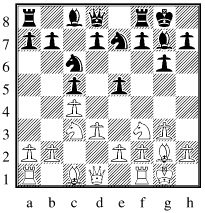
|
| RR v Mark Abbott after 7 ... 0-0 |

|
| RR v Mark Abbott after 18 ... Ne6 |
19 ... f5 Earlier I threatened to exchange his fianchettoed bishop but didn't. he then exchanged mine. Now I should have played f4, but didn't, only to see him play f5. Getting my echoes in first?
20 Bc3 Re8, 21 Qd2 f4, 22 exf4 Bh6 Not a case of pin and win. If
22 ... exf4 I haven't time for Bxg7 as f3+ leaves me with a silly rook. Thus either I need to move the rook into play, conceding the pawn, or get clobbered by recapturing the pawn. eg
23 Nxf4 Nxf4+, 25 gxf4 Qg4+ and the roof falls in. So the Bh6 move was in truth a relief to see.
23 f3 Ref8, 24 bxc5 Nxc5, 25 Rhf1 (missed opportunity: 25 d4 exd4, 26 Bxd4)
25 ... Ne6, 26 Qf2 exf4
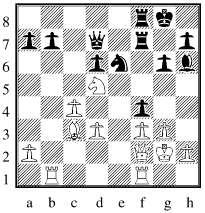
|
| RR v Mark Abbott after 26 ... exf4 |
27 g4 b6, 28 Rfe1 Nc5, 29 Qe2 Qh4 is winning - the interested reader should spend time exploring continuations from here to satisfy themselves that this does lead to significant material gain.
29 ... Bg5, 30 Bd4 Bh4 Presumably Mark was happy with his position, otherwise he could have played Qxg4+ to remove a lot of interest from the game.
31 Bf2 Bf6, 32 Bxc5 (d4 Nb7, 33 Qe6 is clearly much stronger, with black's isolated pawn a permanent problem to him, but having been under (illusory?) pressure I elected for a simplification and reliance on my knight to at least hold the game. The queens soon came off, and we were into endgame territory.)
32 ... dxc5, 33 Qe6 Qxe6, 34 Rxe6 Bh4, 35 a4 Kg7, 36 Rb2 Bf6
37 Rbe2 Bd8, 38 R2e4 h5, 39 h3 hxg4, 40 hxg4 Bh4, 41 Rc6 Rh8 a vain attempt to create counterplay, but it just gives up a pawn for nought
42 Rxf4 Rhf8, 43 Rxf7+ Rxf7, 44 f4 Be1, 45 Re6 Bh4, 46 Kf3 (g5 would have rendered the bishop even more useless)
46 ... Bd8, 47 Ke4 Rb7, 48 Ke5 Bh4, 49 Rc6 a6, 50 Kd6 Kf7
51 Rc8 Bf6, 52 Nxf6 Kxf6, 53 Rf8+ Kg7, 54 Kc6 Re7, 55 Rd8 Kf6
56 Rd6+ Kf7, 57 Rd7 Ke6, 58 Rxe7+ 1-0
I was pleased with this game as although both sides missed good opportunities, almost inevitable at my level, I felt mostly in control againsta player for whom I have considerable respect.
comment on this article
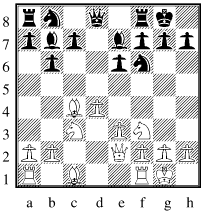
|
| Bill Ingham v RR after 9 Qe2 |
9 ... c5, 10 Rd1 Qc8, 11 d5 allowing a big exchange of material. Do I mind a draw?
11 ... exd5, 12 Nxd5 Nxd5, 13 Bxd5 Bxd5, 14 Rxd5 Rd8, 15 e4 Nc6
16 Be3 Qe6, 17 Qc4
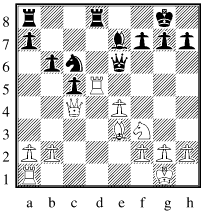
|
| Bill Ingham v RR after 17 Qc4 |
17 ... Rd7 (considered 17 ... Nb4, 18 Rd8+ Rxd8, 19 Qxe6 fxe6 gains control of the d-file at the expense of an isolated e-pawn that white cannot easily pressurize.
but not 17 ... Re8 starting to mount pressure on white's e-pawn)
18 Rad1 Rad8 (18 ... Nb4 virtually forces white to concede queen for rook and minor piece, but RR's mind has found a single track to follow.)
19 a3 Nd4 Trying to be clever, setting up a two dimensional pin. Bf6 is sensible, Na5 wouldn't be the dimmest knight, and even Rxd5 is OK, as the isolated pawn that will be created is easy to blockade.
20 Bxd4 Qxe4, 21 Re5 (21 Rxd7 Rxd7 22 Re1 is better for white)
21 ... Qb7, 22 Ree1 cxd4 (Had expected a doubling of rooks on the e-file, and became very careless. The bishop is till pinned, so Bf8 from me prevents any f7 nasties by uncovering sideways defence.)
23 Ne5 Rd5 Brain completely AWOL. There is no way of maintaining material equality short of setting off the fire alarm and getting the game abandoned. Still there's time for a further blunder:
24 Nc6 Bf6, 25 Qxd5 1-0
A second black for the day comes as no surprise, rather more unexpected is that for the second time today I get an entirely acceptable position early on - playing a gambit line against Oliver Wensley (he beat me here last year) I have a lead in development and a backward pawn to pressurize in exchange for my pawn deficit.
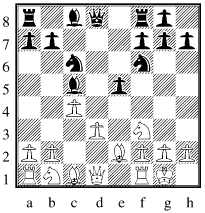
|
| Oliver Wensley v RR after 8 0-0 |
8 ... Qb6, 9 Nc3 Ng4, 10 Ne4 f5 pretending that I still have an attack on f2, but retaining the services of the dark squared bishop is better.
11 Nxc5 Qxc5, 12 h3 Nf6, 13 a3 b6, 14 b4 Qd6, 15 Bb2 Nd7 What is this? I've given up my dark squared bishop that was helping to control d4. Now I'm determined to get behind in development. Is this wise?
16 Qb3 Kh8, 17 b5 Ne7 I like Prokofiev's Dance of the Knights, but this is getting silly.
18 d4 End of backward pawn problem. Could have been worse:
18 Nxe5 Nxe5, Qc3 The e5 knight is pinned against mate and is soon lost to f4. However even with the chosen move white is a pawn up and has pieces dominating the board. It remains a matter of how deep into the endgame i go before resigning. For the masochists amongst you, the rest of the game was:
18 ... e4, 19 Ne5 Nxe5, 20 dxe5 Qg6, 21 f4 Rd8, 22 Rad1 Be6
23 Rxd8+ Rxd8, 24 Rd1 Qe8, 25 Rd6 Nc8, 26 Rxd8 Qxd8, 27 Qc3 Kg8
28 Qd4 Qc7, 29 a4 Kf7, 30 Ba3 Ke8, 31 c5 bxc5, 32 Qxc5 Qxc5+
33 Bxc5 Kd7, 34 a5 Kc7, 35 Kf2 Kd7, 36 Ke3 Ne7, 37 Bxe7 Kxe7
38 Kd4 Bc8, 39 Bc4 Bb7, 40 g4 fxg4, 41 hxg4 h6, 42 a6 Ba8
43 Bb3 g6, 44 Bc2 h5, 45 Bxe4 1-0
As an exhibit into how not to play a gambit opening this is difficult to beat - RR mucked around with trivial threats before surrendering the various factors that originally made the gambit playable. The defeat was just reward for a feeble effort, and returned RR to average for the competition so far.
comment on this article
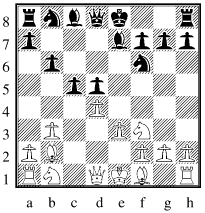
|
| RR v Keith Atkins after 7 ... b6 |
17 ... d4 18 exd4 cxd4
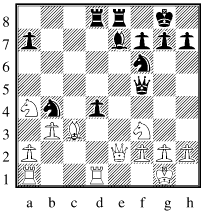
|
| RR v Keith Atkins after 18 ... cxd4 |
20 Qd3 Qxd3, 21 Rxd3 Nxc3, 22 Rxc3 Nd5, 23 Rc4 Nb4, 24 Kf1 Rd3 Bf6 was black's last chance, winning either the exchange or the a-pawn. RR should have course have played 24 a3 to prevent this. The rest of the game sees RR successfully increasing his edge, even if not always by he most efficient means.
25 Re1 Kf8, 26 Nb2 Rd5, 27 Rxe7 Rxe7, 28 Rxb4 Rc7, 29 Rc4 Rcd7
30 Rc2 f6, 31 Nc4 g5, 32 Ne3 R5d6, 33 Rc8+ Kf7, 34 g4 Ra6
35 Rc2 Rad6, 36 Ke2 Kg6, 37 Rd2 h5, 38 h3 hxg4, 39 hxg4 Kf7
40 Rxd6 Rxd6, 41 a3 Rc6, 42 Nc4 Ke7, 43 Nd4 Rc8, 44 Kd3 Rc7
45 b4 Kf7, 46 b5 Re7, 47 a4 Re1, 48 a5 Rd1+, 49 Kc3 Rc1+
50 Kb4 Ke8, 51 b6 axb6, 52 a6 Rb1+, 53 Ka4 b5+, 54 Nxb5 Ra1+, 55 Nca3 1-0
Next up black against Matthew Wilson. Without anything of apparent note happening RR reached the comfortable position shown on move 12.
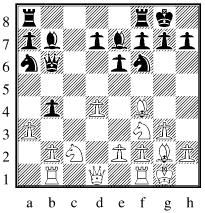
|
| Matthew Wilson v RR after 12 Rab1 |
14 f3 Bd5, 15 Ne3 d6, 16 N5c4 Rfd8, 17 Nxd5 Nxd5, 18 Bd2 Rac8
19 Ne3 Qb6 I'm sure there were some thought processes behind this move, but I can't remember them now. Hopefully this means I'll never have them again. Exactly why would I want blockaded doubled isolated pawns?
20 Nxd5 No surprise exd5
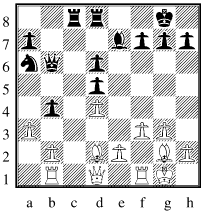
|
| Matthew Wilson v RR after 20 ... exd5 |
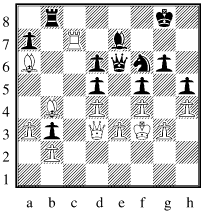
|
| Matthew Wilson v RR after 40 Rc7 |
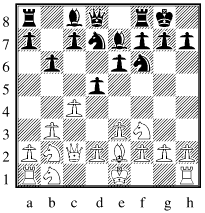
|
| RR v David Lawrence after 7 ... b6 |
18 Bxf6 Qxf6, 19 Rxh7 Ba6
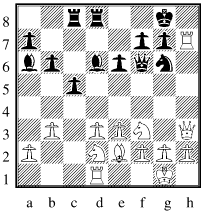
|
| RR v David Lawrence after 19 ... Ba6 |
20 ... Qb2 Now I can see a mate. Will he let me have it?
21 Nfg5 Qxe2 Yes!
22 Rxg7+ 1-0 (mate in two)
So the congress ended as it started, with a fairly crude but successful piece attack on my opponents king.
Four wins with white, three losses with black, yet I find it difficult to put the latter down to my choice of black openings, as in each case I got satisfactory positions. guess it just happens that way sometimes. Just wish it wouldn't!
comment on this article
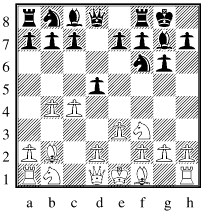
|
| RR v Kasik Wozniak after 5 ... d5 |
6 cxd5 Nxd5, 7 Bxg7 Kxg7, 8 Qb3 Nc6, 9 a3 a6, 10 Bc4 Nb6
11 Be2 e5, 12 Nc3 Be6, 13 Qb2 f6, 14 d3 Qe7, 15 O-O Qf7
16 Rac1 Bb3, 17 Bd1 Bxd1, 18 Rfxd1 Rad8, 19 Ne4 With the white squared bishops gone I'm not concerned about Na4 as after Qc2 black has nothig better to do than retreat the knight as protecting it is only possible at the cost of the c6 knight. Indeed his c7 pawn is something of a concern to black, which may explain his next move:
19 ... Na7
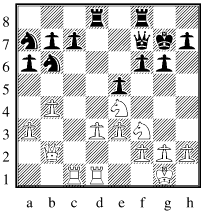
|
| RR v Kasik Wozniak after 19 ... Na7 |
20 Nxe5 fxe5, 21 Qxe5+ Kg8, 22 Rxc7 Rd7, 23 Rdc1 Nc6, 24 Rxd7 Nxe5
25 Rxf7 Rxf7 Equal but different material should be handled with care, but RR becomes cavalier:
26 d4 Nc6 (Nec4 would have caused white much more inconvenience)
27 Nd6 RR goes for a trick to craete a 2 v 1 queenside majority, but perhaps should have gone for a slower plan utilizing his connected passed central pawns.
27 ... Re7, 28 Nxb7 Nxd4, 29 exd4 can't allow the fork on e2
29 ... Rxb7 RR still has 3 pawns for the piece, but an isolated central pawn and a pawn advantage on each wing is liable to become very bitty. However I suspect my previous victories were playing on Kasik's mind, so he did not have the belief that his position was OK.
30 Kf1 Kf7, 31 Ke2 Ke6, 32 Kd3 Nd5, 33 g3 Rc7 34 Rxc7 Rc5 offering to reconnect my pawns must be better.
34 ... Nxc7, 35 Kc4 Kd6, 36 a4 Kc6, 37 f4 h5, 38 h3 Kd6
39 g4 Ke6 (Nd5 and RR is really struggling)
40 Kc5 Nd5 What a difference a move makes. Now Nd5 is a blunder which brings proceedings to an abrupt halt, though in truth having allowed white's king to c5 black is in trouble anyway.
41 f5+ 1-0
comment on this article